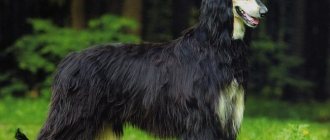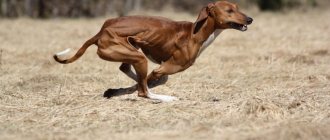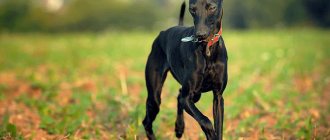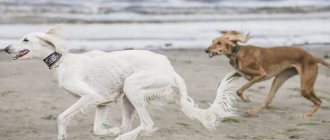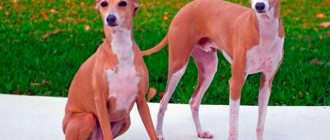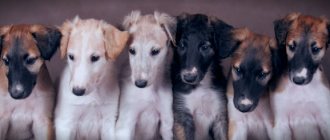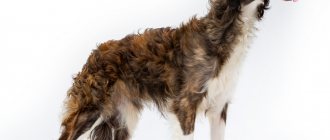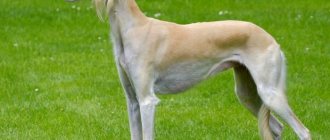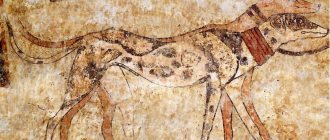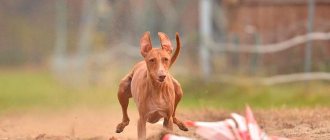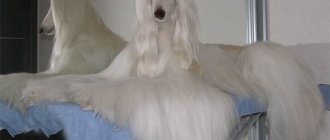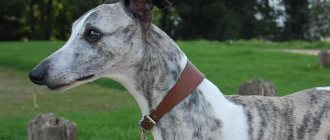The pride of Russian cynology, russian hortaya greyhound, attracts with its outstanding hunting and running skills and appearance. This dog is used to hunt hare, fox and saiga; she is able to cope even with a wolf. Hortaya is the recognized “master of catching” among all greyhounds. There are legends about her endurance: a young greyhound chased a gazelle for 6 kilometers and “took” it. Dirt does not stick to her smooth short fur and thorns do not stick. These greyhounds feel great in the hot regions of our country. The breed standard was first described in the early 50s of the 20th century.
Origin story
Hortyhounds were bred on the Black Sea steppes of Asia. Their genus dates back to the mid-19th century, but for a long time the breed was used as a commercial breed and had no pedigree. Horty greyhounds were first described in the documentary works of P.M. Gubin (1801) and P.M. Machevarianov (1876). The specifics of hunting in the steppes required the work of an appropriate type of greyhound, which would specialize in foxes, hares and saigas.
When creating the breed, dog breeders paid attention, first of all, to the working characteristics of the dogs, and not to their exterior. The dog was valued for its ability to mark, overtake and capture a cunning and cautious animal that could move very quickly.
This explains the fact that the bulk of greyhounds were represented by mestizos, who did not have pedigrees, but had excellent working characteristics. The Horta Greyhound standard was compiled by K.M. Esmont and A.V. Lerche closer to the middle of the 20th century. Only the efforts of enthusiasts made it possible to significantly increase the number of the breed. But in 1923, the total extermination of the Russian Horty dogs followed, and during the Second World War, only a few of these dogs remained. But only using these preserved specimens was it possible to preserve and revive the breed.
Historical reference
The birthplace of the entire greyhound family is Arabia. It is believed that dogs so valuable for hunting spread to Egypt and countries that are now considered Mediterranean, even before the invention of guns. It is unknown whether greyhounds were deliberately bred; there is a version that the breed originated through aboriginal means. There are also serious doubts about whether they hunted with greyhounds in Egypt. Judging by data from historical reference books, in Ancient Egypt dogs were more identified with religion than with trade.
The Russian Hortai Greyhound is considered a direct descendant of the Salyuga, the greyhounds whose images were depicted in frescoes dating back to 4, 5 and even 7 thousand years BC. Another ancient homeland of greyhounds is Afghanistan. Found rock paintings proved that the territory was actively hunted with dogs that caught up and crushed the beast.
With the merchant fleet, greyhounds spread throughout Europe and Asia. It’s interesting that fast, lean hunters were welcome everywhere. In each territory, new species of hunting greyhounds appeared, which were used for both hunting and sporting purposes.
In Asia, a tradition was established to hunt with greyhounds on horseback, and this can be called a decisive event for the popularization of the breed. The fashion spread not only across the mainland, but also around the world, and hunting with greyhounds became a sign of high status. In England, for example, commoners were completely forbidden to keep greyhounds and the point was not to protect nature, but to delineate social class - the poor had to be different from the nobility. The status of greyhounds has been repeatedly confirmed by slightly absurd laws, for example, banning the sale of representatives of the breed to Indians.
On the territory of Russia, the pride of the Khorty greyhounds were dogs that many people wanted to own. It is known that in order to strengthen relations with Great Britain, Victoria I received several pairs of Horty greyhounds as a gift. If we omit the political aspect, the queen, who was very fond of dogs and all the “shows” associated with four-legged animals, had a positive influence on the popularization of Horty greyhounds in England and Europe.
Description of the Hortaya Greyhound breed and characteristics
In many ways, the appearance of the Horta Greyhound is similar to the standard exterior of greyhounds. It is characterized by a strong, moderately narrow body. Height of males – 65-75 cm and above, females – 61-71 cm, weight of males – 25-35 kg, females – 18-25 kg. The head, in proportion to the body, is not large; on the skull there is a pronounced bump on the back of the head, called the “falcon”. The muzzle is narrowed and dry. The forehead is slightly sloping, neatly transitioning into a slanted nose, on which a slightly noticeable hump is allowed. The pigmentation of the nasal lobe is dark.
There is a scissor bite. The eyes are slanted, large, and their irises are characterized by different shades of brown. The ears are small and stand low, their shells are thin, and the ears themselves are located along the neck. Even if the dog is alert, their soft tips are thrown to the side or forward. The muscles on the long neck are clearly visible, but the neck itself is slightly compressed on the sides.
A strong, elongated body, a deep chest, quite spacious, oval in shape. The ribs protrude slightly, immediately behind the elbow joint, forming a barrel-shaped increase, sloping towards the abdomen. On a strong back there is a clearly visible wither, gradually lowering, turning into a hollow.
A slight convexity on the wide loin decreases closer to the tail. According to the rules, the tail lowered down is quite long, the tip is curled into a half ring. In most cases, there is no dewlap or fringe on it (or is barely pronounced). The belly is carefully selected. The limbs are long and parallel, the joints are well defined. The forearm is longer than the shoulder, and the lower leg is longer than the thigh. The hind legs stand wide and slightly pulled back. On the front legs the shape of the foot is round, and on the hind legs it is closer to oval. The feet themselves are arched, slightly compressed on the sides.
We advise you to read: Top most beautiful dog breeds
Although the Horta Greyhound has many features that make it similar to Greyhounds, their muscle groups are distributed and developed differently. There are also differences in the structure of the skull, especially the muzzle. This muscular structure affects the speed abilities of short greyhounds, allowing them to easily overtake even fast saigas reaching speeds of up to 90 km/h. In addition, these dogs have simply extraordinary endurance. They tirelessly chase prey throughout the daylight hours. With a commercial hunt lasting up to 3-4 weeks, greyhounds work through a full season without failure. Thanks to the streamlined body shape and lightness of the skeleton, greyhounds can reach even higher speeds than hounds. To change the balance of the body in the process of rapid movement, the dog only needs to tilt its long neck.
In an article about this breed, K.M. Esmont called their paws “iron”, because they allow the dog to fly headlong across the frozen ground without slowing down. The persistence and agility of the Horta Greyhound allows it to give a head start to a dog of any other breed - it only needs one lightning-fast throw to overtake its prey. Due to their keen vision and instant reaction, short greyhounds can distinguish prey at a fairly impressive distance of several kilometers. A wide field of vision is provided by the elongated shape of the muzzle.
As if compensation for all the phenomenal abilities, the sense of smell in dogs of the Hortai breed is not the sharpest. But the most valuable qualities in the breed have always been lightning speed of reaction, visual acuity and attentiveness.
There are a number of minor differences between the greyhound varieties of the north and south. For example, Stavropol greyhounds are more graceful, with light bones, short dewlap on the tail and hind legs, and almost no undercoat. Greyhounds from Rostov are distinguished by rough bones, high stature and slightly longer coats with a characteristic undercoat. However, all differences do not go beyond breed standards.
Azawakh
The smooth-haired greyhound comes from Mali (Africa). Initially it was used as a hunter “with sight”, and also as a companion of rich nomads. The height at the withers is 64-74 cm for males and 60-70 cm for females. Body weight depends on gender and ranges from 15-25 kg.
The dog has a refined physique, with muscles and bones clearly visible under the skin. The body of the Azawakh is rectangular, supported by long limbs. The dogs' heads are elongated, dry, and rather narrow. Characteristic features include thin drooping ears and a long tail with a white tassel. The color is always red with markings. The nature of the dogs is reserved, the Azawakh is distrustful of strangers and affectionate with loved ones.
Coat type and color
The Short Greyhounds have a smooth coat that lies tightly on the body. It is characterized by straight hairs, without kinks, elastic, up to 2.5 cm long. The weak undercoat is almost absent in the warm season.
The color can be zonal or solid. To describe the color of the Shorthound, special terms were even introduced. In particular, the colors of these dogs come in the following types: gray and fawn (various shades), forelock, murugi, black and white with fawns, and there are also a number of colors with the so-called mazurina - the presence of an obligatory dark shade of the mask on the face and the tips of the paws in general fawn, gray or red color.
For the colors of this breed, the All-Russian Pedigree and Stud Book not only used special terms to describe the shade, but also indicated its location. This is how the names appeared: forelock white-breasted, white half-eared, black and piebald with forelock tan and others.
We advise you to read: Chinese dog breeds
There are not very prominent spots on the coat, which are in harmony with the base color. When the color is solid, then, as a rule, the upper part of the body is darker in comparison with the limbs and belly.
Feeding rules
Short greyhounds are genetically endowed with a high metabolic rate, which ensures energy supply to all organs and, in particular, muscle tissue. Therefore, food should contain foods with high calorie content - carbohydrates in the form of cereals, flour products (bread). Porridges are well boiled, but coarse ones, such as oatmeal, are given only crushed.
Young and adult dogs need raw meat and canned meat for plastic processes. Both carcasses of small animals - gophers, for example, as well as offal and animal fat are suitable for feeding. Greyhounds do not digest pork well, so the amount should be limited or completely eliminated.
The diet should be supplemented with vegetables - potatoes, carrots, beets, cabbage. It is advisable to alternate vegetables. Greens are introduced into the food - beet and carrot tops, young scalded nettles. The food should be liquid - porridge is poured with milk, buttermilk, whey. Dogs are also given other dairy products - cottage cheese, hard cheese.
Strong bones and healthy teeth are formed with sufficient amounts of phosphorus and calcium. Vitamins, micro- and macroelements should be included in the greyhound’s diet not only with food (bone meal, fish, bones), but also in the form of mineral and vitamin supplements, rock salt. Food should be warm and fresh. The dog should always have fresh water.
If the owner does not have the opportunity to cook for his pet himself, he can feed him ready-made diets. The best option is premium and super-premium category food. They have a balanced composition and do not require additional feeding with vitamins and minerals. The only thing the owner needs is to provide the pet with constant access to water.
FINNISH SPITZ (FIN. SUOMENPYSTYKORVA, ENG. FINNISH SPITZ) HUNTING BREED OF DOG
FILA BRAZILEIRO (BRAZILIAN FILA, BRAZILIAN MASTIF, ENGLISH FILA BRASILEIRO)
THE PHARAOH HOG IS LEAN, MUSCULAR, GRACEFUL, FAST AND AGILITY
FRENCH BULLDOG WITH A FRIENDLY CHARACTER
Greyhound character
The intelligence and independence of the Horta Greyhound are distinctive qualities that are not characteristic of every breed. For short greyhounds, these characteristics are especially important, because they do not walk on the pack, but accompany the hunter at a distance of 10-15 meters, while during the pursuit of prey they can be several kilometers away from him, which, in itself, makes recoil impossible commands
The constant presence of this dog close to other animals (horses, dogs) and humans makes the presence of aggression in its character unacceptable. The extermination of aggression in the breed was carried out using a rather cruel, but effective method - a dog that showed aggression towards people was destroyed. As a result, the Horta Greyhound's temperament turned out to be so trusting that she would easily go with any stranger. The sociality of animals of this breed is extremely high, which explains their gregariousness.
Horty greyhounds living in the city absolutely retain the instincts of a hunter. This dog is brave, reckless and malicious towards animals, therefore, despite its peaceful coexistence with people and dogs of its type, it considers small animals (squirrels, cats, etc.) to be prey and is capable of attacking.
But, nevertheless, the greyhound is quite “loyal” to pets and birds, especially when they live together in a country house. The greyhound's temperament is quite restrained, and it is friendly and sociable. When young, dogs can be active and even choleric.
The Horta Greyhound does not have a territorial sense, so it is not a watchman. But excellent eyesight allows her to notice even the shadow of a stranger and bark to warn her owner. Over time, some dog breeders have learned to train Horts in such a way that they can make good guards.
Australian Kelpie - Cattle Dog
Description of the breed
The Australian Kelpie has a fairly compact body. The height at the withers is on average 45 cm, and the weight usually does not exceed 20 kg. The Australian Kelpie has a special appearance: a long body, a powerful, wide chest, a strong croup, short but powerful legs. The head is proportional to the size of the body; the skull is slightly rounded and wide between the ears. Pronounced transition from forehead to muzzle. The cheeks are not rough, not protruding, but roundly leading to the muzzle, which is clearly “chiseled”. The muzzle is slightly shorter than the length of the skull. The lips are dense and “clean”, not saggy. The color of the nose matches the coat. The overall appearance is reminiscent of a fox-like expression, softened by almond-shaped eyes.
The Australian Kelpie's ears are erect and pointed; the skin is thin but strong at the base, the ears are set wide apart and tilted forward, with slightly curved outer edges, of medium size. The inside of the ear has quite thick fur.
The Australian Kelpie has a two-layer coat consisting of an undercoat and a water-repellent topcoat. As you can see in most photos of Australian Kelpies, their color is predominantly black with fawn markings on their paws, but there are also representatives with brown-red, chocolate and even ash-blue fur.
The body of the Australian Kelpie has well sprung ribs, a deep rather than wide chest, a level topline, a strong and muscular loin, and deep flanks. The length of the body (from the anterior protrusion of the sternum to the ischial tuberosities) is greater than the height at the withers and is 10/9.
Origin
The first mentions of kelpies in literary sources date back to the end of the 19th century. In particular, it is said that for the first time in the history of Australia, a shepherd competition, which took place in 1872, was won by a certain Royal Kelpie. His parents are known, but the rest of his ancestors can no longer be traced.
There is no established opinion among researchers about the origin of the breed today. Some believe that kelpies are descended from collies brought to Australia by early settlers. Others point out that they are of the Rutherford line of English collies from the North County, which, like many other sheepdogs, were brought here at the end of the last century. There is also a version according to which there is a fairly high probability that wild Australian dingoes participated in the formation of the kelpie breed.
Best articles: Herbivores, or herbivorous animals: features, list, types and photos
The kelpie's ancestors were "smooth-coated, black and tan collies" with erect ears, brought from Scotland to Australia in the 1860s. In 1872, a female dog of this breed named Kelpie won the first shepherd competition - this dog is considered the progenitor of the breed named after her. The word "kelpie" is of Gaelic origin and means "water spirit". Dogs of this breed with black coloring are called “Barbs”.
However, it is reliably known that in its homeland this dog breed has continuously improved, and their targeted selection at one of the leading Australian kelpie breeding farms, Enfinvale, began in 1956. The owner of this farm, Tim Austin, giving lectures to students of the Faculty of Agriculture at the University of Munich, names a number of genetically determined qualities of the kelpie that distinguish them from other dogs
The most interesting thing for us is that they have a very wide viewing angle, which allows maximum visual control of the object of observation. Further, Tim Austin emphasizes the features of the kelpie's brain, which allows it to concentrate maximum attention on the object
Kelpies came to Russia in 1987 and also by miracle. The 1.5-2 month old babies who arrived from Australia with accompanying documents of origin were immediately distributed to two state nurseries. One of them is in Kazakhstan, the other is in Stavropol.
Kelpies are in great demand. Despite the fact that their average cost is about 10 times higher than a merino queen, farmers are willing to buy them, since the cost of purchasing such a dog pays off within a few months. In Australia, the working qualities of the kelpie are highly valued, which is why they do not release them freely from the country, primarily satisfying their own needs for these dogs. There are currently more than 100,000 kelpies working in Australia.
Pros and cons of the breed
The Hortai is a fairly rare type of greyhound; it has been bred and kept for hunting since ancient times. These dogs are mostly owned by hunters - residents of remote areas of the steppe. And the Hortai Greyhound absolutely justifies its status as a most valuable worker and friend, as well as a breadwinner responsible for supplying food to the master’s table. The value of a good greyhound in the steppe is higher than that of a good riding horse.
When raising, you should understand that this breed of dog usually lives freely in the steppe and gets used to independent actions. This leaves its mark and can lead to difficulties in training, since the pet can demonstrate stubbornness and zero reaction to commands.
Key points in training
The rapid growth of urbanization has no effect on the popularity of hunting. Therefore, before getting a pet, think about whether you can give it the opportunity to express itself in its hunting role.
The puppy must be taught to control himself. Therefore, it is tedious to accustom him to different commands. For example, he needs to be taught that he can touch food only after the owner’s command. All this will help to raise a disciplined individual.
Lack of good exercise leads to the loss of abilities of the Russian greyhound and the gain of excess weight.
It is very important to teach your pet not only basic, but also special commands that will help the dog distinguish hunting from everyday situations. To make the process of training and socialization easier and more enjoyable, you should contact professionals who know the intricacies of the breed’s behavior.
The dog's training process should take place in a calm and pleasant atmosphere. In this case, you need to immediately position yourself as a leader for the dog. She must respect her master. Physical influence during education is strictly prohibited.
How to care for a Horta Greyhound?
Dogs of this breed are not demanding in care. Since they have almost no undercoat, you can use a brush or mitten for combing, without any separate devices. After a walk, a thorough inspection of your pet’s fur is required to check for ticks and fleas. If the dog lives in an apartment, then after a walk it is necessary to wash its paws. There is no need for frequent bathing - for a Horta greyhound, a complete wash 1-2 times a year is enough.
We advise you to read: Dog Breed German Shepherd
Nail trimming is not required, especially if the dog often runs on hard surfaces. But from the very beginning it is worth teaching the puppy to brush his teeth, since their health is valued not only in specimens going to the exhibition, but teeth also represent an important working tool for this breed.
Distinctive features
Tuareg hounds appear very thin in appearance - a narrow, elongated muzzle, leather-covered ribs and thin paws. But, in fact, for a dog living in a hot climate, this is absolutely normal.
Azawakhs are taller than long. Cables can reach up to 74 cm at the withers, females up to 70. The weight of the dog varies between 15 and 20 kg. Despite the bonyness, the breed looks quite harmonious and fit. Greyhounds have an athletic body type and can reach high speeds (about 60 km/h) in a short period of time.
The standard structure is characterized by certain characteristics:
- The head is narrow and long, but shorter than that of other hunting dogs. The skull is flat with an unpronounced frontal bone. The back of the head is rounded and streamlined. The cheeks are flat or sunken.
- The muzzle is elongated and narrowed. The bridge of the nose is slightly rounded and forms an arch above the nose. The jaw bones are clearly visible, the bite is scissor-like, the mouth is strong and strong. The nose is brownish or black in color.
- The eyes are wide-set and almond-shaped. The slanting of the eyes is caused by the high position of the outer corners. The iris can have either dark brown or amber pigment.
- The ears are wide at the base and tapered towards the end, forming a triangle; quite long, hanging down, not standing. Buying is not accepted.
- The neck is moderately long, flexible, smoothly transitions into the thoracic region, there is no dewlap. The withers are clearly defined.
- The body is thin and fit: the chest is flat, wide with clearly defined rib bones; the belly is tucked up, seems sunken, which determines the stateliness and elegance of the dog, the back is short and straight.
- The limbs are elongated, thin, but strong and muscular. Joints and tendons are visible. Paws are medium-sized, round in shape with pronounced toe joints. The claws are dense and strong with brownish and black pigments.
- The tail is low set, medium length, thin. Wool, like on the body. A white spot may be present at the end. The shape is sickle-shaped, a loop is often observed.
- The coat is thin and very short. Almost absent on the stomach. The color can be found in different variations of color and patterns.
Field leisure of Horty greyhounds and hunting
The dog of this breed is a steppe hunter. The field leisure time of the Hort greyhounds is quite active - they go with her to fox, saiga, hare and wolf. The incredible endurance of this dog allows it to work literally from morning to night. Compared to its “closest relatives”, it can catch up with the beast at long distances - 4 km or more. And to repeat such a “race” again, she only needs to rest a little after the first. To hunt a small animal, the Hort greyhound can be used alone, but a pack of greyhounds is used to hunt antelope, wolves and various large ungulates.
The Hortai greyhound instantly strangles a small animal immediately after it catches it, and holds a large one until the hunters arrive. At the same time, the division of food and hunting instincts in the short greyhounds is quite clear - having taken prey, the dog will not tear it or eat it, but will wait until the owner takes it. This indicates a flexible nervous system, allowing the greyhound to quickly calm down.
Content Features
The Hortai Greyhound remains a working breed, used for hunting, and when selecting studs, the most important are working qualities. The list of climatic zones in which a dog can live and hunt includes hot southern regions and rather cold forest-steppe and wooded areas. The dog is not adapted to living and working in severe frost conditions, so it has not taken root in the northern and southern regions of Russia.
Working horses are not suitable for indoor housing. Living outside allows the dog to get used to any weather and develop the necessary muscles. In the yard, dogs are usually kept in an outbuilding or an insulated shed, or less often in a kennel. Within the four walls of a house, a greyhound quickly weakens and is suitable for hunting only after long training. In addition, working dogs definitely need walking distances of about 10 km, daily if possible. The Hortai should do half the distance in a swoop.
Care
The Hortai Greyhound does not require special care. It is enough to comb it occasionally and bathe it as needed. Periodically inspect, clean the ear and monitor the condition of the claws.
Photos of Horta Greyhound
Mating
Now let's talk about mating an Arabian greyhound. The animal’s body is most prepared for bearing offspring and giving birth at the age of 2 years. You shouldn't take your dog before. A good time for conception begins on the 11th day of estrus, when spotting appears. This period lasts no more than 6 days. Before breeding a bitch, you need to walk her, but you don’t need to feed her. A bitch is brought to a dog for mating
This is an important condition for successful mating. First, the animals are introduced and given time to sniff.
The dogs can even run and play during the process. You should not interfere with animals in this matter. If the bitch is ready to conceive, mating will definitely occur. During this process, the dogs stand in the castle for 20 minutes to 1 hour, and they cannot be split. After a day, the mating should be repeated.
